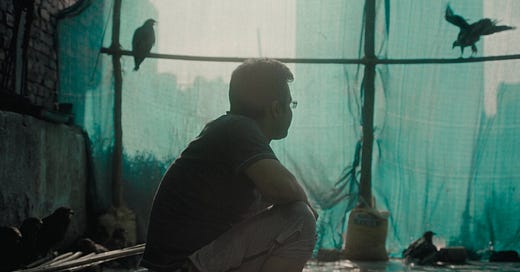All That Breathes
A decidedly cinematic documentary looking at some New Delhi men working to save predatory birds from the industrialization of India.
“All That Breathes” is an Oscar-nominated documentary, though personally I’m not really sure how accurate that description is.
Not the Academy Award; it was indeed one of five feature films that recently got the nod. No, I’m talking about the documentary part.
It’s an engrossing and engaging look at men in New Delhi working to save the predatory birds being killed off by rapid industrialization in India. Directed by Shaunak Sen, it’s a decidedly cinematic effort featuring long tracking shots, pans and high-angle viewpoints we associate more with fictional movies than the eye-level look of documentaries.
It looks really good for a documentary. Too good, in fact, for me to believe the filmmakers chose these complex cinematography techniques and then the footage we see is what just happened in front of the camera. It feels more like they set up these shots and then the bird-healers performed for posterity.
I’m not casting aspersions on the motives of the men or the documentarians, but am registering my observation about the experience of watching the film. It feels very much like watching a fictional story about people working to save birds rather than a journalistic observation.
Is that… bad? I don’t necessarily think so. I don’t get the sense anything was deliberately staged or faked. Certainly, there are spontaneous moments that would be impossible to do so, such as when a bird flying by snatches a man’s glasses right off his face.
What I am saying is that “Breathes” is a very polished film that is unlike the raw, jittery-camera aesthetic we associate with spur-of-the-moment documentaries. It feels more like something that is being presented to us than what just happened.
The movie focuses primarily on three men: brothers Nadeem and Saud, and their younger assistant/friend, Salik. They run a soap dispensary business out of the family home, but their real passion is saving black kites, the hawk-like predatory birds that dot the sky of New Delhi like stars in the night sky.
The city seen in this documentary is glorious and dank, fetid and breathing with all sorts of life. Humans live right next to dogs, cows, rodents, untold varieties of insects and other organisms. To Western eyes, it is filthy and unsanitary. But to these men, it is simply part of the environment they grew up in.
Saud is the primary medical caregiver, fixing broken wings, patching up wounds, rehydrating and releasing as many kites as they can. He is upbeat and usually smiling. In contrast, Nadeem runs the business side of things, applying for grants and taking care of the machinery that constantly breaks down, such as the grinder that turns the donated scrap meat into a dough-like chum they use to feed the birds.
Salik is the goofy comedic relief and tension-breaker, as the brothers are often at odds these days. Nadeem feels unappreciated and is searching for chances to study abroad, ostensibly to gain more expertise to help their bird sanctuary but partially to escape Saud’s shadow.
Against this dynamic of slowly rising tension, there is overt violence playing out in the background. Religious riots between the Hindis and Muslims are growing closer and closer to their home. As Muslims, the brothers fear being sent off to Pakistan, despite having never lived there.
To me, the most interesting part of the film is how the brothers see the relationship between humans and the kites. They calculate how much garbage the birds eat, keeping more filth from polluting the community’s waterways and habitat. In a sense, the birds act like the healthy bacteria in the human digestion system, breaking down waste.
“Humanity is now their natural environment,” Nadeem observes.
Oddly, the men do not speak rapturously about their love of the birds, other than how they liked watching them float on the air currents as boys. Their medical skills are self-taught, and they operate out of a long-born habit rather than any romantic calling that is seen or expressed.
It’s just what they do. This does tend to make it harder for the audience to become emotionally invested in their mission.
As the years have gone by the documentary genre has wandered further and further away from its observatory roots. Filmmakers now go into a given subject or scenario with an idea for the movie already fully formed in their mind, rather than waiting to see what the camera will capture. Many are expressly political and opinionated.
I was surprised when I started seeing screenwriting credits appear in documentaries. How could something be written ahead of time for it to be a document of what happened spontaneously in real time? If you’re talking about assembling the footage and putting narration to it, that’s part of the editing process to my mind. Still, writing credits probably accompany half or more of documentary features now.
As it happens, “All That Breathes” does not have writing credits. Nor is it brazenly pushing a viewpoint or demanding that we support the bird refuge.
Still, it is a further step away from the roots of documentary filmmaking. Is it the unadorned truth of what happened, or did the presence of the observer’s camera encourage the subjects to actively try to tell their story? I think the latter.
Whether that’s good or bad, I’ll leave up to you. From my perspective, I’d call it nonfiction storytelling rather than a true documentary.
For me, the most thrilling moment is when that kite flies off with the man’s eyeglasses. He is at first dazzled by the randomness of it, though later he regrets the cost of the glasses. I loved it because there’s no way anyone could have predicted what would come to pass, which is what true observational filmmaking is all about.





